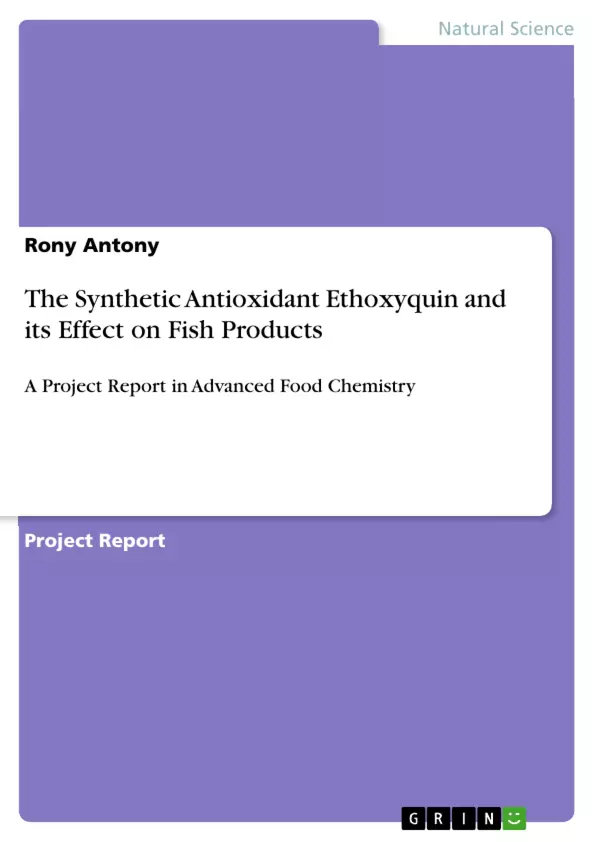This work analyzes the effects of the antioxidant Ethoxyquin on fish products. The synthetic antioxidant Ethoxyquin is widely used, specifically in the fishmeal industry in order to prevent the fishmeal from lipid oxidation. New implemented regulations of EU do not allow to incorporate any traces of EQ on feed in some countries within the Europe. But in many countries, it is used in some spices like rosemary and chilli to preserve their color. The toxicity of EQ is the major problem which creates some harmful effects on human and animals when animals are fed with the feed containing EQ. At the same time, humans are affected indirectly by other means. The project report tries to present the physical and chemical properties of EQ, its working mechanism as an antioxidant in fishmeal, positive and negative attributes of EQ on feed, feed ingredients, human and animals, regulations and requirements of the incorporation of EQ on different feed, the reauthorization part and the replacement of EQ by some alternative natural and/or synthetic compounds as well.
Three major synthetic antioxidants are used in food industry especially in processed feed such as fishmeal. These are Ethoxyquin (6-ethoxy-1,2-dihydro-2,2,4-trimethylquinoline) (EQ), Butylated Hydroxytoluene (2,6-di-tert-butyl-p-cresol) (BHT) and Butylated Hydroxyanisole (tert-butyl-4-hydroxyanisole) (BHA). Other synthetic antioxidants such as octylgallate and propylgallate have no significant role, even though among all the synthetic antioxidants, ethoxyquin is mostly used because of its low production costs and higher antioxidative effect.
Ethoxyquin has been widely used in fishmeal as an antioxidant and its antioxidant capacity through free radical scavenging mechanism has been widely understood. However, when toxigenicity in human and animals is considered, the use of ethoxyquin is still in a bewildered stage for a decision. A combination of multiple antioxidants (either natural or synthetic or a combination of natural and synthetic) with less toxicity and stability along with some emulsifying or chelating agents may provide some good results. In order to do so, extensive data collection and research have to be conducted. Through this process, stabilization and reauthorization is possible to a greater extent and the present huddle can be minimized. Knowing the toxicity, the regulating body shall consider the maximum inclusion level of EQ on feed and feed ingredients.
Table of Contents
- Abstract
- Introduction
- Chemical structure
- Mechanism of Ethoxyquin as an antioxidant
- Toxicity
- Regulations and requirements
- Limits of ethoxyquin residuals in human food
- Natural alternatives
- Discussion
- Conclusion
- References
- Abbreviations
Objectives and Key Themes
This project report explores the use of the synthetic antioxidant Ethoxyquin (EQ) in the fishmeal industry. It delves into the chemical structure and mechanism of action of EQ, its toxicity, and the regulations surrounding its use in food and feed. The report also investigates the potential for using natural alternatives to EQ.
- The properties and mechanism of action of Ethoxyquin as an antioxidant
- The toxicity of Ethoxyquin and its impact on human and animal health
- Regulations and requirements regarding the use of Ethoxyquin in feed and food
- The search for natural alternatives to Ethoxyquin
- The role of Ethoxyquin in preventing lipid oxidation in fishmeal
Chapter Summaries
- Abstract: This chapter provides a concise overview of the project report, highlighting the key points and research questions addressed.
- Introduction: This chapter sets the stage for the report by introducing the use of synthetic antioxidants in the food industry, particularly in fishmeal. It discusses the three major synthetic antioxidants, including Ethoxyquin, Butylated Hydroxytoluene (BHT), and Butylated Hydroxyanisole (BHA), and explains why Ethoxyquin is widely used due to its cost-effectiveness and strong antioxidative properties.
- Chemical structure: This chapter will delve into the chemical structure of Ethoxyquin and its role in preventing lipid oxidation in fishmeal.
- Mechanism of Ethoxyquin as an antioxidant: This chapter will explain the mechanism of action of Ethoxyquin as an antioxidant. It will describe how Ethoxyquin interrupts the chain reaction of lipid autoxidation, thereby preventing the degradation of fishmeal.
- Toxicity: This chapter will explore the potential toxic effects of Ethoxyquin on human and animal health. It will examine the harmful effects of Ethoxyquin when ingested through contaminated feed and other indirect routes of exposure.
- Regulations and requirements: This chapter will discuss the current regulations and requirements concerning the use of Ethoxyquin in feed and food products, particularly in different countries.
- Limits of ethoxyquin residuals in human food: This chapter will detail the specific limits for Ethoxyquin residues in human food, ensuring the safety of consumers.
- Natural alternatives: This chapter will explore the potential use of natural alternatives to Ethoxyquin, considering their effectiveness and sustainability as replacements for the synthetic antioxidant.
Keywords
Ethoxyquin, Fishmeal, Antioxidant, Lipid oxidation, Toxicity, Regulations, Natural alternatives, Food safety, Synthetic antioxidants, BHT, BHA, Feed, Human health, Animal health
- Quote paper
- Rony Antony (Author), 2017, The Synthetic Antioxidant Ethoxyquin and its Effect on Fish Products, Munich, GRIN Verlag, https://www.hausarbeiten.de/document/453908


